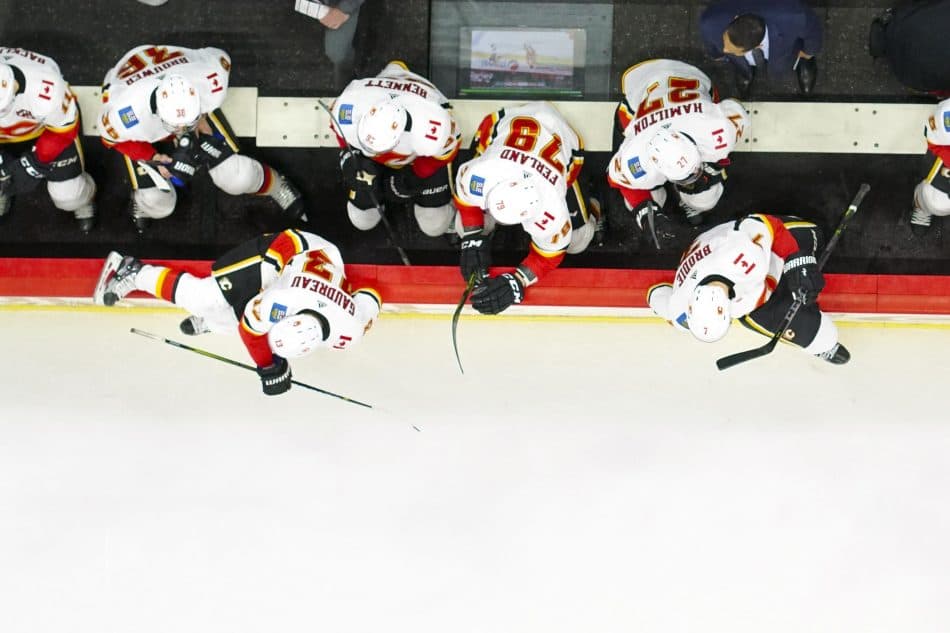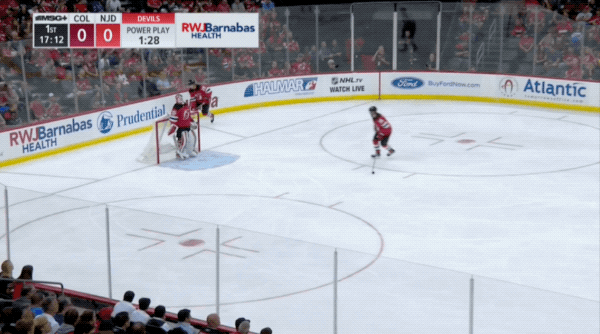What to expect from Geoff Ward’s power play

By Ryan Pike
5 years agoWhen the Calgary Flames’ season began going down the tubes in roughly February, many began calling for the head of assistant coach Dave Cameron (and head coach Glen Gulutzan by extension) for the team’s woeful power play. Not only did general manager Brad Treliving swing the axe and clear out the big league bench, but he went out and hired Geoff Ward away from the New Jersey Devils.
A veteran coach with a Stanley Cup ring from Boston’s 2011 triumph over Vancouver, Ward has spent a decade in the NHL running power plays – primarily good ones. So what can Flames fans expect to see from the Flames power play beginning in 2018-19? After some poking around, here are our general expectations.
Four forwards, one defenseman (probably)
During Ward’s entire run in the Garden State – and much of his time in Beantown – his power plays ran with four forwards and one defenseman. Throughout much of this season, even through injuries and call-ups, the Devils ran two units of four forwards and one defenseman. More and more, special teams units with two defenders are the exception and not the rule.
The usual first unit for the Devils this season was Taylor Hall, Kyle Palmieri, Travis Zajac, Will Butcher and one of Patrick Maroon or Brian Boyle. That’s a lot of left shots. But it’s not the mixture of players that’s particularly novel, but rather how Ward positioned and deployed them.
The ever-familiar 1-3-1 structure, with a twist
The Devils used a variation on the familiar 1-3-1 structure: a defenseman at the top of the zone distributing the puck; two players up the slot for tips, redirections or quick passes; and players on the two wings to either shoot or pass defending if lanes are available. The Washington Capitals have famously used the right-shot Alexander Ovechkin on his “off” (left) side for quick one-timers, and a lot of teams have followed suit.
But more recently, things have flipped a bit. Tyler Dellow over at The Athletic examined the newer phenomenon where wingers are actually staying on their strong side. Here’s his explanation regarding what’s been happening:
So you don’t get the release as quickly as you do when one timing the puck but then the league is littered with players who can’t one time the puck. Instead, the movement makes it harder for a goalie to have all of the angles covered on the goal. There’s not just east/west movement of the puck — there’s north/south movement as well, which means that the goalie has to change his depth.
The strong-side winger allows for a more precise shot, but also avoids telegraphing the one-timer because a quick pass is just as viable an option. And the lack of reliance on the rapid-fire one-timer also means that you see the puck miss the net and careen off the glass and out of the offensive zone less frequently – there’s less of a blind panic to get the shot off.
The Flames utilized this strategy at times last season, but it was less structured and a bit messy. The variable quality and health of their right-shot options (Troy Brouwer, Kris Versteeg and very little else) also created challenges that they’ll need to overcome this summer.
Failed to load video.
Chaos in the slot, ideally
The side effect of the strong side wingers is some added precision and an entire system that’s seemingly design to create maximum chaos in the slot and net-front area. The wingers are making the goaltender shift around. The two attackers up the middle are (a) creating screens, (b) creating tips and (c) in an ideal position to outnumber the defenders for loose rebounds. And the point man at the top of the zone has a lot of bodies providing cover for his shot – Butcher got a ton of points last year based on the chaos unfolding in front of the opposing net.
There’s a potential variation of this scheme to think about: Bill Peters alluded to looking at using a forward below the red line (behind the net), which would create different looks and lanes and essentially force the goaltender and defenders to spin around rather than get used to a particular viewpoint on the ice. It’s still a 1-3-1, but a very different look that’s also based on creating chaos in the net-front area.
In other words, expect a lot less perimeter play from the 2018-19 power play.
More variation on zone entries
How many times did TJ Brodie skate very rapidly towards the offensive blueline, only to awkwardly stop and chuck the puck back to Johnny Gaudreau in the neutral zone? It’s called “the bump-back” by coaches and it’s the worst thing the power play has seen in years. You’re basically screaming to the opponent, “Don’t worry, Gaudreau’s bringing it in!”
Well, the Devils had a lot of fun, creative zone entry schemes. I watched five complete games worth of power plays. I saw zero bump-backs. But I saw this, which is largely resemblant of how much Ward wants his players to keep the defenders guessing. (Stick-tap to Mike Pfeil for the gif.)

Breeding predictability out of the special teams units seems to be the goal.
Faceoff improvements
The easiest way to avoid worrying about zone entries is by winning offensive zone faceoffs consistently. While it’s hardly a “tactic” per se, the Devils’ most common players at the dot won a lot of their draws and it helped them keep the pressure on. Pavel Zacha (61%) and Boyle (58%) took most of their draws, but Hall (63%), Nico Hischier (50%) and Drew Stafford (69%) also took a lot and won a lot.
For the Flames, Sean Monahan took the vast majority of draws at a 51% winning rate, followed by Mikael Backlund at 47%. The Flames will need to be better at the dot, and it’ll probably also be beneficial for them to get some more right-handed players that can take draws.
(Hopefully) more goals
The Flames scored 43 power play goals on 269 opportunities this past season. The Devils had 54 goals (11 more) on 252 opportunities (17 fewer). If the Devils had the same number of power plays as the Flames and scored at their same rate, they would’ve put up 58 goals. Even if the Flames can split the difference, an additional six or seven power play markers at key times in key games could be huge in 2018-19.
Recent articles from Ryan Pike





